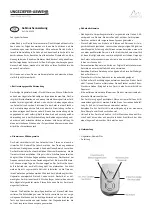Reviews:
No comments
Related manuals for Dual OptoLED

DSN-640
Brand: D-Link Pages: 40

RF
Brand: Vasco Pages: 32

AK-10
Brand: Abra Pages: 16

Connect
Brand: SAI Pages: 16

One
Brand: Hable Pages: 3

AMX JPK-1300
Brand: Harman Pages: 2

TL300
Brand: T-Link Pages: 3

FM100
Brand: MacDon Pages: 32

M7500
Brand: K&K Pages: 6

2236
Brand: Wang Pages: 68

TSE Series
Brand: NAVITAS Pages: 14

FPC-36040
Brand: Matelec Pages: 16

BAYSTAT033AC
Brand: Trane Technologies Pages: 8

LB-762
Brand: LAB-EL Pages: 25

62323
Brand: Cardigo Pages: 12

TempMaster M2 Plus Series
Brand: Mold-Masters Pages: 2

FTC80
Brand: Spirax Sarco Pages: 24

TMCM-1240
Brand: Trinamic Pages: 30

















